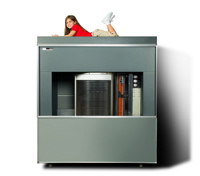Finally, a Hard Drive Large Enough to Run Windows Vista …

Information is stored, magnetically, on 50 disks, which rotate at 1200 rpm. These disks are mounted so as to rotate about a vertical axis, with a spacing of three-tenths of an inch between disks. This spacing permits two magnetic heads to be positioned to any one of the 100 concentric tracks, which are available on each side of each disk. Each track contains 500 alphanumeric characters. Total storage capacity: 5,000,000 characters. The two recording heads are mounted in a pair of arms, which are moved, by a feedback control system, in a radial direction to straddle a selected disk. This new system promises memory storage possibilities never before accomplished.”
We’ve come a long way from those halcyon days of RAMAC storage, haven’t we? Those days when hard drives had to be moved with forklifts and stored just five megabytes of data–barely enough to hold a single song in MP3 format.
This week researchers at Toshiba and Japan’s Tohoku University said they’d jointly developed a next-generation technology called Nanocontact Magnetic Resistance (NC-MR) that allows them to squeeze more than a terabyte of data onto a square inch of drive. To put that in perspective, consider this: The current storage density record for a shipping product is just 178.8 gigabytes per square inch. Quite an achievement, eh? That said, it’s one that’s at least five years from market. Which in this case is a good thing, I suppose, because we’re going to need a few years to develop an appetite for the quantity of locally stored, high-definition content it promises.









